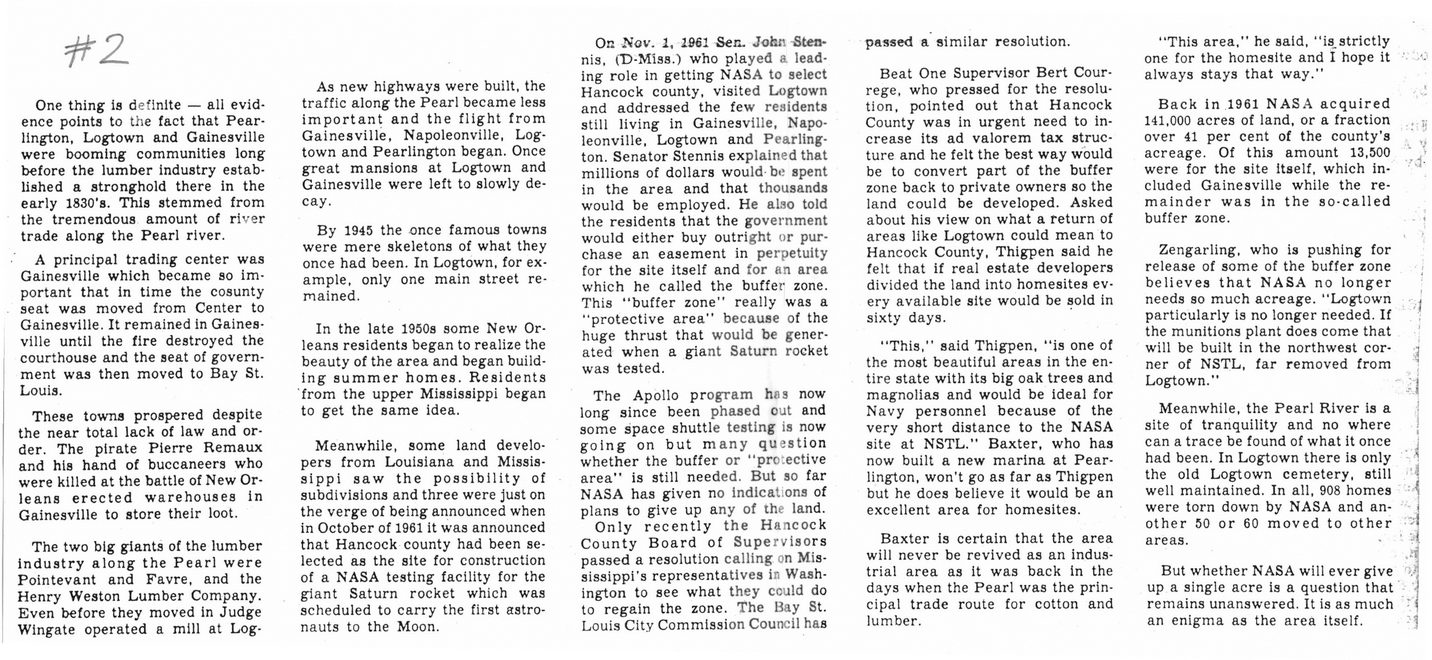This text was obtained via automated optical character recognition.
It has not been edited and may therefore contain several errors.
One thing is definite — all evidence points to the fact that Pearlington, Logtown and Gainesville were booming communities long before the lumber industry established a stronghold there in the early 1830’s. This stemmed from the tremendous amount of river trade along the Pearl river. A principal trading center was Gainesville which became so important that in time the cosunty seat was moved from Center to Gainesville. It remained in Gainesville until the fire destroyed the courthouse and the seat of government was then moved to Bay St. Louis. These towns prospered despite the near total lack of law and order. The pirate Pierre Remaux and his hand of buccaneers who were killed at the battle of New Orleans erected warehouses in Gainesville to store their loot. The two big giants of the lumber industry along the Pearl were Pointevant and Favre, and the Henry Weston Lumber Company. Even before they moved in Judge Wingate operated a mill at Log- As new highways were built, the traffic along the Pearl became less important and the flight from Gainesville, Napoleonville, Logtown and Pearlington began. Once great mansions at Logtown and Gainesville were left to slowly decay. By 1945 the once famous towns were mere skeletons of what they once had been. In Logtown, for example, only one main street remained. In the late 1950s some New Orleans residents began to realize the beauty of the area and began building summer homes. Residents from the upper Mississippi began to get the same idea. Meanwhile, some land developers from Louisiana and Mississippi saw the possibility of subdivisions and three were just on the verge of being announced when in October of 1961 it was announced that Hancock county had been selected as the site for construction of a NASA testing facility for the giant Saturn rocket which was scheduled to carry the first astronauts to the Moon. On Nov. 1, 1961 Sen. Johr, Stennis , CD-Miss.) who played a leading role in getting NASA to select Hancock county, visited Logtown and addressed the few residents still living in Gainesville, Napoleonville, Logtown and Pearlington. Senator Stennis explained that millions of dollars would be spent in the area and that thousands would be employed. He also told the residents that the government would either buy outright or purchase an easement in perpetuity for the site itself and for an area which he called the buffer zone. This ‘‘buffer zone" really was a "protective area" because of the huge thrust that would be generated when a giant Saturn rocket was tested. The Apollo program has now long since been phased out and some space shuttle testing is now going on but many question whether the buffer or "protective area” is still needed. But so far NASA has given no indications of plans to give up any of the land. Only recently the Hancock County Board of Supervisors passed a resolution calling on Mississippi's representatives in Washington to see what they could do to regain the zone. The Bay St. Louis City Commission Council has passed a similar resolution. Beat One Supervisor Bert Cour-rege, who pressed for the resolution, pointed out that Hancock County was in urgent need to increase its ad valorem tax structure and he felt the best way would be to convert part of the buffer zone back to private owners so the land could be developed. Asked about his view on what a return of areas like Logtown could mean to Hancock County, Thigpen said he felt that if real estate developers divided the land into homesites every available site would be sold in sixty days. "This,” said Thigpen, “is one of the most beautiful areas in the entire state with its big oak trees and magnolias and would be ideal for Navy personnel because of the very short distance to the NASA site at NSTL." Baxter, who has now built a new marina at Pearlington, won't go as far as Thigpen but he does believe it would be an excellent area for homesites. Baxter is certain that the area will never be revived as an industrial area as it was back in the days when the Pearl was the principal trade route for cotton and lumber. “This area,” he said, "is strictly one for the homesite and I hope it always stays that way." Back in 1961 NASA acquired 141,000 acres of land, or a fraction over 41 per cent of the county's acreage. Of this amount 13,500 were for the site itself, which included Gainesville while the remainder was in the so-called buffer zone. Zengarling, who is pushing for release of some of the buffer zone believes that NASA no longer needs so much acreage. "Logtown particularly is no longer needed. If the munitions plant does come that will be built in the northwest corner of NSTL, far removed from Logtown." Meanwhile, the Pearl River is a site of tranquility and no where can a trace be found of what it once had been. In Logtown there is only the old Logtown cemetery, still well maintained. In all, 908 homes were torn down by NASA and another 50 or 60 moved to other areas. But whether NASA will ever give up a single acre is a question that remains unanswered. It is as much an enigma as the area itself.

Logtown State and Local News - Pearlington, Logtown, Gainesville (60)